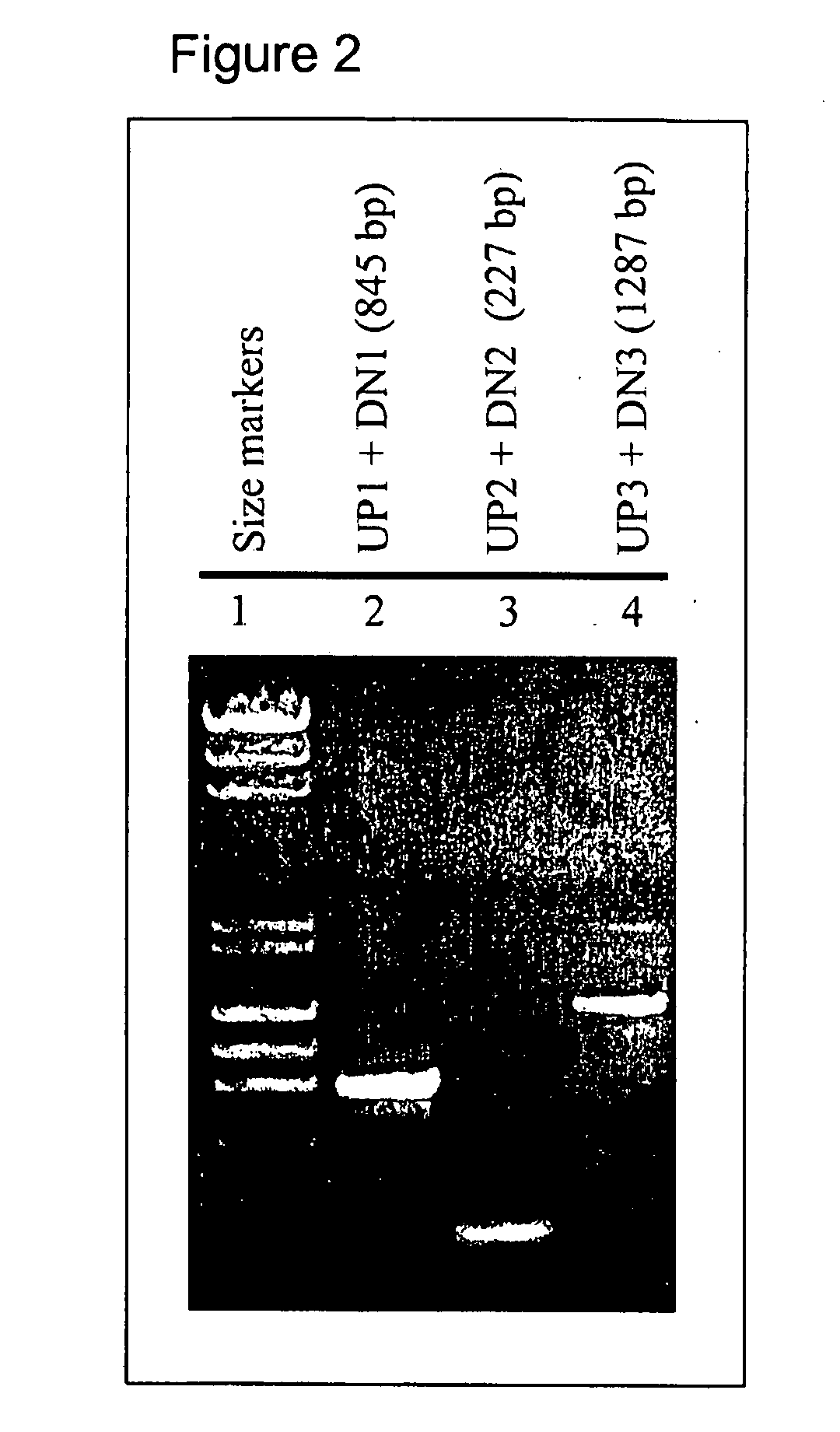Canine Cholecystokinin 1 Receptor Materials And Their Use
a technology of cholecystokinin and receptor materials, which is applied in the direction of biological material analysis, peptides, dna/rna fragmentation, etc., can solve the problem of limited interpretation of these data
- Summary
- Abstract
- Description
- Claims
- Application Information
AI Technical Summary
Benefits of technology
Problems solved by technology
Method used
Image
Examples
example 1
Cloning of the Canine CCK1 Receptor
[0100]Cloning of a partial cDNA fragment of canine cholecystokinin 1 receptor (CCK1R) from canine gallbladder tissue by RT-PCR was performed by employing oligonucleotide primers complementary to the conserved region cDNA sequence between the human and rat CCK1 receptors (Accession Numbers 113605 and M88096). βactin primers were obtained from Maxim Biotech, Inc (San Francisco, Calif.). The upstream primer, UP1 (SEQ ID NO.:1), corresponding to base pairs 307 to 321, and the downstream primer, DN1 (SEQ ID NO.:2), corresponding to pase pairs 1152 to 1172 (FIG. 1, with sequences shown in Table 1), amplified an 845-bp PCR product corresponding to the majority of the middle region of the canine CCK1 cDNA (FIG. 2).
TABLE 1Sequences and species specificity ofoligonucleotide primersPrimerSequenceSpeciesUP15′-CTGCTCAAGGATTTCATCTTCGG-3′human / rat(SEQ ID NO.:1)DN15′-GGGAAGGTGGCCATGAAGCC-3′human / rat(SEQ ID NO.:2)UP25′-CATTTCCTTCATCCTCCTGCTGTCCcanineT-3′(SEQ ID NO....
example 2
Analysis of Tissue Distribution of the Canine CCK1 Receptor
[0108]Semi-quantitative RT-PCR analysis of canine CCK1 receptor expression was performed in order to determine the tissue distribution of canine CCK1. Five □g of total cellular RNA was reverse transcribed using oligo dT primer following manufacturers instructions (TaqMan RT, Applied Biosystems, Foster City, Calif., USA). To conduct real-time PCR, 5 μl of cDNA was incubated with 25 μl SYBR Green (Applied Biosystems), 3 μl of 5 mM of forward and reverse primers (forward primer (SEQ ID NO.:7):5′-CATCTACAGCAACCTGGTGC-3′, reverse primer (SEQ ID NO.:8): 5′-GTGGACAGCTGCCGGAGCTC-3′) and 14 μl water to give a total volume of 50 μl. The PCR reaction was conducted using the iCycler™ real time PCR machine (Bio-rad, Hercules, Calif., USA) and the cycle times were 1×95° C. 4 min, 35×1 min 60° C., 1 min 72° C., 1 min 94° C. All samples were assayed in triplicate and samples where no reverse transcriptase had been included were used as cont...
example 3
Comparison of the Affinity Values Estimated at the Cloned Canine and Human CCK1 Receptor and at the Canine CCK2 Receptor
[0110]Compounds and materials used in the experiments described in this and in the following examples include [125I]-BH-CCK-8S (specific activity ˜2200 Ci.mmol−1), which comprises a sulfated eight amino-acid cholecystokinin peptide that has been radioiodinated by Bolton-Hunter conjugation (see, e.g., Bolton et al., 1973, Biochem. J, 133(3):529-539), was supplied by Amersham, Buckinghamshire, UK. 2-NAP (2-naphthalenesulponyl 1-aspartyl-(2-phenylethyl)amide), YF476 ((R)-1-[2,3-dihydro-2-oxo-1-pivaloylmethyl-5-(2′-pyridyl)-1H-1,4-benzodiazepin-3-yl]-3-(3-methyl-phenyl)urea), YM022 (1-[(R)-2,3-dihydro-1-(2-methylphenacyl)-2-oxo-5-phenyl-1H-1,4-benzodiazepin-3-yl]-3-(3-methylphenyl)urea), L-364,718 (3S(−)—N-(2,3-dihydro-1-methyl-2-oxo-5-phenyl-1H-1,4-benzodiazepine-3-yl-1H-indole-2-carboxamide), L-365,260 (3R(+)—N-(2,3-dihydro-1-methyl-2-oxo-5-phenyl-1H-1,4-benzodiazepi...
PUM
| Property | Measurement | Unit |
|---|---|---|
| Temperature | aaaaa | aaaaa |
| Temperature | aaaaa | aaaaa |
| Temperature | aaaaa | aaaaa |
Abstract
Description
Claims
Application Information
 Login to View More
Login to View More - R&D
- Intellectual Property
- Life Sciences
- Materials
- Tech Scout
- Unparalleled Data Quality
- Higher Quality Content
- 60% Fewer Hallucinations
Browse by: Latest US Patents, China's latest patents, Technical Efficacy Thesaurus, Application Domain, Technology Topic, Popular Technical Reports.
© 2025 PatSnap. All rights reserved.Legal|Privacy policy|Modern Slavery Act Transparency Statement|Sitemap|About US| Contact US: help@patsnap.com



